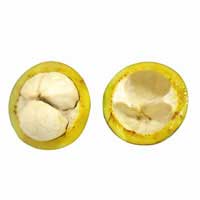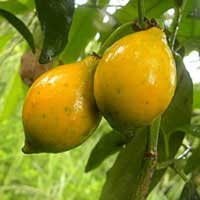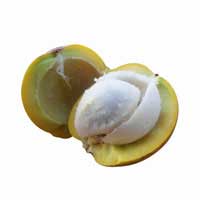 Full List of Fruits
Full List of Fruits  Bacuri Fruit
Bacuri FruitBacuri Fruit
Scientific name - Platonia insignis
Platonia insignis also known as Bacuri is considered to be one of the tastiest and healthiest among fruits. Native to South America, this fruit closely resembles papaya in color and shape. The Bacuri insides consist of a white pulp with just about three to five seeds. The pulp surrounds the seeds and gives a sweet and sour taste. It is also highly fragrant which probably made man curious enough to try it out.
The Bacuri tree is a dry season, deciduous tree, growing up to 25 to 40m in height. The fruit looks more like a rounded papaya with thick skin protecting the white pulp. The color also resembles the papaya color and can grow from 7 to 14cm in length.
![]() Nutritional Value of Bacuri fruit
Nutritional Value of Bacuri fruit
The bacuri fruit is rich in essential vitamins and minerals, including vitamin A, vitamin C, iron, magnesium, and potassium. It is also a good source of dietary fiber, protein, and polyunsaturated fatty acids. These nutrients are important for maintaining overall health and provide many health benefits.
| Calories | 39Kcal=163kJ |
| Carbohydrate | 7.1g |
| Protein | 1.0g |
| Dietary fiber | 2.0g |
| Total fat | 1.0g |
![]() Health Benefits of Bacuri fruit
Health Benefits of Bacuri fruit
Bacuri is also used in traditional medicine to treat a variety of illnesses, including fever, diarrhea, and malaria. It is also believed to help prevent cancer and other chronic diseases. The fruit is also used to make cosmetics and skin care products
The Bacuri is used as a flavoring agent in Ice creams, Jellies, Jams, Pie Fillings, Ice popsicles and much more. The white meat by itself can also be consumed. A butter made from the fruit is said to be extremely effective in treating Skin problems. Skin rashes, infections and other skin related issues can be treated by Bacuri butter. It is also used as an herbal medicine for ear pain and cure insect and snake bites. Based on these applications, cultivation of this fruit can be promoted and encouraged on a great level.
Growing this fruit is fairly easy, given the fact that it does not require soil that is rich in nutrients or other additives. Any sort of cultivation via propagation by seed, grafting or cuttings from the root do not pose any problems. However care should be taken throughout the growth. At first they should be sown in a nutrient rich, light textured ground or soil. Germination period is about two to three months, after which they are transported to nurseries for further care. This is when the plant is about 20cm tall and remains in nurseries till they are about 60cm tall.
The Bacuri fortunately is not a fussy plant and can survive through thick and thin. Based on this feature, this plant may become the next big thing in oil, forestry, agro forestry, nuts and fruits. Extensive research is being done on how to extract as much as possible from this beautiful fruit.
Medicinal Uses: Bacuri fruit has long been used as a folk remedy for a variety of ailments. The bark, leaves, and fruit can be used to treat skin infections, digestive problems, fever, and even malaria. It is also used as a pain reliever and anti-inflammatory agent.
Culinary Uses: The pulp of the fruit is often eaten raw or added to desserts, juices, and smoothies. It can also be boiled and used as a sauce for savory dishes. The seeds are sometimes toasted and used as a seasoning.
Skin Care: The fruit's oil is a great skin moisturizer and can be used to treat dry, cracked skin. It is also used to treat skin problems such as eczema, psoriasis, and acne.
Hair Care: The oil from the fruit can be used to treat dry, damaged hair. It is a natural conditioner and can help to strengthen the hair follicles.
Weight Loss: : The fruit is high in fiber and can help to reduce appetite and promote weight loss.
Antioxidant Properties: The fruit is a great source of antioxidants, which help to protect the body from free radical damage. This can help to reduce the risk of certain diseases, such as cancer and heart disease.


















